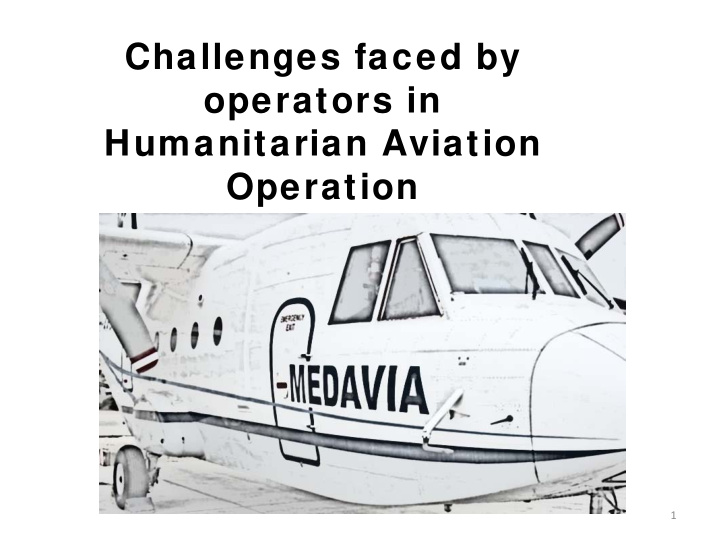



Challenges faced by operators in Humanitarian Aviation Operation 1
2
– Remote locations – RWY incursions – RWY condition – RWY excursions – Maintenance facilities Quick senior management risk demonstration – SAR resources – Crew Wellbeing – RFFS issues – Weather – Security issues – Fuel issues 3
Sometimes you just need some more light 4
Does my safety case cover this? Operational management issues Even if the worst case scenario doesn’t happen, what about aircraft retrieval? 5
6
Varied facilities Hangared maintenance Ramp based resources and resources outsourced hangarage But it still needs to be part of your risk assessment! 7
8
RWY incursions Whether by animal (RI.A’s) or vehicular, aircraft or human (RI.VAP) control of unfenced runways will always be problematic. RI.A mitigation strategy’s This is increased where populations have been allowed to inhabit land adjacent to the manoeuvring areas. Mitigations: • Man fence. • Vehicle hot spot map. • Using google earth to identify likely high traffic human/animal footpaths, tracks and causeways. • Crew awareness. • Ground crew/staff awareness/inspections. • Ground personnel backtrack. Note MDM felt that low pass was more risky than ground inspection. 9
Further mitigations ‘In house’ RWY hotspot maps & risk assessments 10
Possible causes: ● Approach fast (Vref+15kts) ● Is to high ● Touchdown point is long (not clear) ● T ailwind ● Contaminated RWY ● Wet RWY (forecast WX vital) ● Unstabilized approach ● ‘Floated’ landing 11 (very likely if they are apprehensive about RWY contamination or trying to avoid a burst tyre)
RWY excursions and condition starts with acquisition… Typical desert airstrips Identification sometimes not easy 12
Once you’ve got it… condition and markings vary… as do the frangibility of some obstructions! The ideal 13
RWY contamination is also 14 linked to the next subject…
RWY Excursion Mitigations: Operational risk assessment for each sector. VFR - Stabilized approach. GA accepted in preference to an unstable approach. Low energy at touch down. Real time ‘verified’ RWY condition + WX is key. Clear markings, frangible distance to go markers, duplicate approach plates helpful. Good perspective, vital. No holes & no black holes! ‘Length is always nice to have’ 15
16
Blue Sky fit 17
18
Wellbeing Freedom Rest Eat anywhere Susceptibility to Hygiene disease Limited eating Susceptibility to places & menu illness Vaccinations Fatigue 19
20
Domestic units pressed into More up-to-date cab controlled service monitors RFFS dedicated 21
Risk Mitigation Take off, initial climb, approach, landing incidents only Red = incidents that involved a fire event 22
AM: Early morning fog… PM: Running before the sand… 23
Isolated bases / camps Light defensive capability (Libya) 24
Security issues Traditional New threats Nokia K95 stun gun (tazer) 25
26
Poor fuel – Potential for AEO 27
Fuel handling • The problem of getting the message across to multiple handlers. The problems of fuel • quantity issues and discrepancies with various handlers, with differing standards of equipment and accuracy. • Mitigation: Fuel policy and crew awareness of vital role fuel and fuel quality plays in keeping the aircraft airborne. 28
Fuel storage & handling 29
End 30
At your service 31
Recommend
More recommend